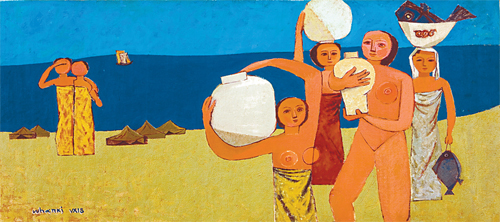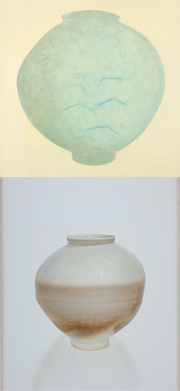Moon jars conjure up the beauty of mid-Joseon art

“Women in Jar” (1951) by late painter Kim Whan-ki. Provided by the organizer
This idea is encapsulated in a new exhibition that opens today at Gallery Hyundai Gangnam in Sinsa-dong, southern Seoul.
“Artists and Moon Jars” presents a number of paintings, sculptures and photographs of dalhangahri, moon jars that were designed along very simple lines but that create an elegant and silent surrounding.
“Traditional moon jars have long been a symbol of beauty in Korea,” said Koh Hee-kyung from the gallery. “Even today, their classic shape and plain color is highly popular.”

Top:“Moon Jar” (2008) by Kang Ik-joong, Above “Life” (2002), a drawing by Ko Young-hoon
The jars were used for holding flowers and storing alcohol and soy sauce.
Most traditional moon jars are white, a color that represents integrity and clarity.
Korean Western-style painters To Sang-bong (1902-1977) and Kim Whan-ki (1913-1974) are the exhibition’s two primary artists.
The moon jars they portray create artistic beauty from emptiness. For example, “Lilac” (1974), one of To’s oil paintings on display at the exhibition in Sinsa-dong, portrays a bunch of shaded lilac in a moon jar.
Kim’s “Women in Jar” (1951), a more colorful and elegant oil painting, is representative of the artist’s love of moon jars.
Kim said his desire to be an artist was born when he first saw moon jars that dated back to 18th-century Korea.
Other pieces at the exhibition are more simple in design.
A moon jar captured by contemporary photographer Koo Bohn-chang delivers sentiments of generosity in “Vessel” (2006).
Two moon jars from the 18th century are also on display.
“Though moon jars are plain and artless, they shed more light as a subject of an art,” Koh said.
The “Artists and Moon Jars” exhibition runs until Feb. 10. To reach Gallery Hyundai Gangnam, southern Seoul, take Apgujeong subway station, line No. 3, exit 2. Today and on Feb. 1 at 2 p.m., Yoo Hong-joon, former director of the Cultural Heritage Administration, is giving a lecture on the stories behind moon jars.
For more information, call (02) 519-0800 or visit www.galleryhyundai.com.
By Lee Eun-joo Staff Reporter [angie@joongang.co.kr]










with the Korea JoongAng Daily
To write comments, please log in to one of the accounts.
Standards Board Policy (0/250자)